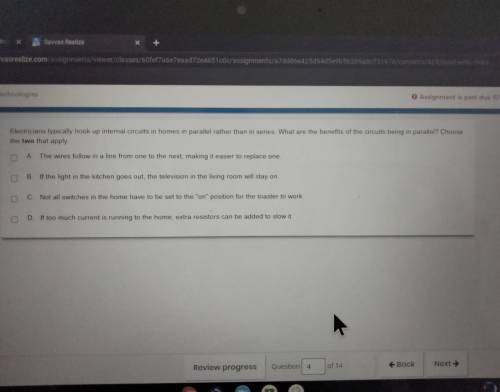
Physics, 25.01.2022 02:10 erinolson07cats
Electricians typically hook up internal circuits in homes in parallel rather than in series What are the benefits of the circuits being in parallel? Choose the two that apply A The wires follow in a line from one to the next, making it easier to replace one B. If the light in the kitchen goes out the television in the living room will stay on oc Not all swiches in the home have to be set to the "on" position for the toaster to work Di too much current is running to the home extra resistors can be added to slow it


Answers: 3


Another question on Physics

Physics, 21.06.2019 20:00
Alice added sodium chloride to water and stirred the water for several minutes. alice is most likely trying to demonstrate that ionic compounds a. are hard. b. can dissolve. c. are clear. d. can melt.
Answers: 1

Physics, 21.06.2019 22:30
Follow these directions and answer the questions. 1. shine a pencil-thin beam of light on a mirror perpendicular to its surface. (if you don't have a laser light as suggested in the video, you can make a narrow beam from a flashlight by making a cone from black construction paper and taping it over the face of the flashlight.) how does the light reflect? how does the relationship of incident to reflected ray relate to the reflection of water waves moving perpendicular to a barrier? 2. shine a pencil-thin beam of light on a mirror standing on a sheet of paper on the table (or floor) so that you can mark the incident ray and reflected ray. (you can support the mirror from the back by taping it to a wooden block.) 3. mark a line on the paper representing the reflective surface. (the reflective surface of a mirror is usually the back edge.) 4. draw a dashed line perpendicular to the mirror surface at a point where the incident and reflected ray meet. this perpendicular is called a normal to the surface. 5. measure the angles between the rays and the normal. the angle of incidence is the angle formed by the incident ray and the normal to the surface. the angle formed by the reflected ray and normal is called the angle of reflection (r). what is the angle of incidence? what is the angle of reflection? 6. repeat for several different angles. (see report sheet for details.) what appears to be the relationship between the angle of incidence and angle of reflection? in science 1204, what was the relationship for these two angles made by the reflection of waves in a ripple tank? 7. roll a ball bearing so that it hits a fixed, hard surface (a metal plate) at several angles (including head-on). observe the way in which the ball bearing reflects. what generalization can you make about how a ball bearing reflects from a wall? have you proved that light can only behave like a wave?
Answers: 1

Physics, 22.06.2019 02:50
What is required for an electric charge to flow through a wire? zero resistance in the wire a balance of electric potential high resistance in the wire a difference in electric potential
Answers: 1

Physics, 22.06.2019 07:30
The charge on a charged sphere is: a)concentrated at its centerb)distributed uniformly throughout its volumec)clustered on its centerd)distributed uniformly over its surface
Answers: 1
You know the right answer?
Electricians typically hook up internal circuits in homes in parallel rather than in series What are...
Questions




Social Studies, 11.04.2021 03:00



Mathematics, 11.04.2021 03:00



Engineering, 11.04.2021 03:00

Social Studies, 11.04.2021 03:00




Social Studies, 11.04.2021 03:00

SAT, 11.04.2021 03:00


Mathematics, 11.04.2021 03:00


Health, 11.04.2021 03:00



